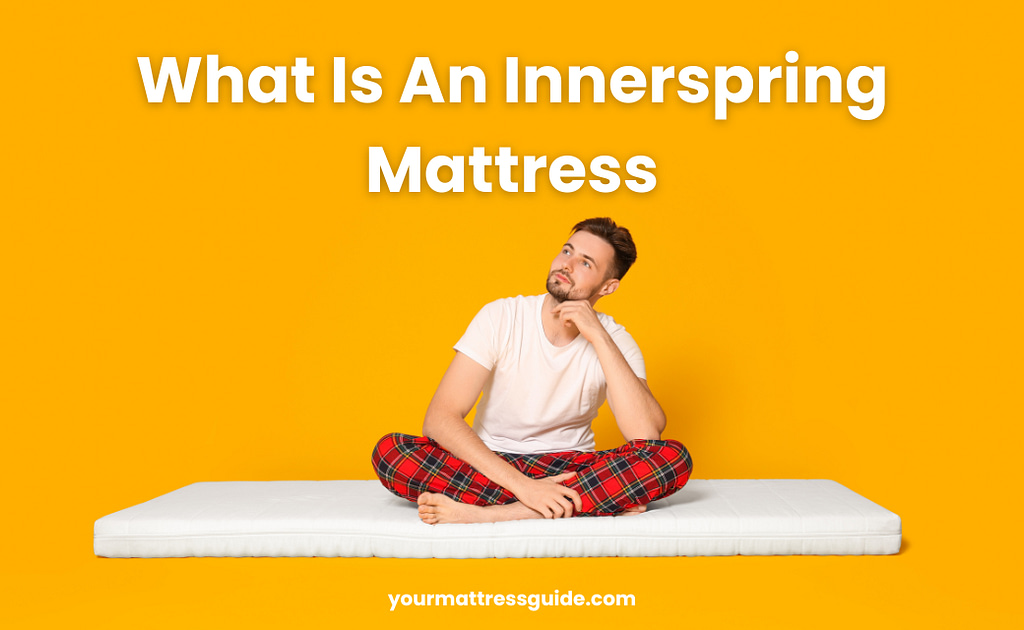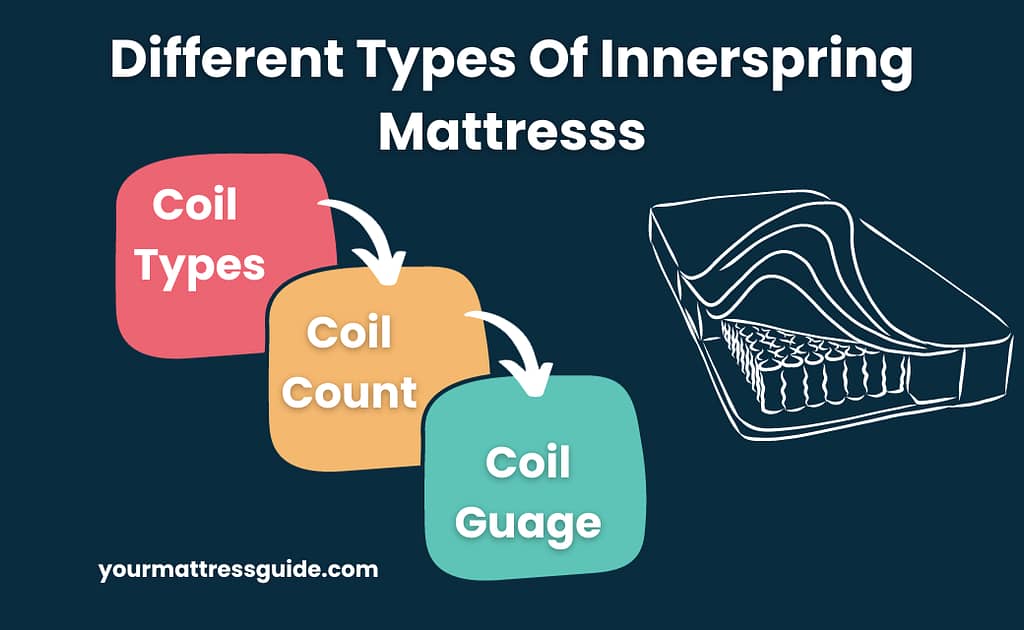Metal coils, often composed of steel, are used in innerspring mattresses to offer support. These coils, linked together or wrapped in fabric separately, provide a sturdy and long-lasting foundation for the bed. An innerspring mattress’s size, shape, and number of coils, as well as the cushioning and materials surrounding it, can all affect how comfortable, firm, and supportive it is.
Therefore, this comprehensive guide will discuss everything related to Innerspring mattresses, including types and benefits.
So, without further interruptions, let’s get on with today’s blog.

What Is An Innerspring Mattress Different Types Of Innerspring Mattresss
Innerspring mattresses come in various forms, each with distinctive features and construction. An innerspring mattress simply has one support system: the coil unit.
You should constantly consider the coil gauge, kind, and quantity.
These elements assist you in determining whether a bed is a good fit for your sleeping style and how well it functions.
Coil Types:
- With a significant bounce and considerable motion transfer, Bonnell coil mattresses can have a more conventional sensation.
- While still offering strong support, offset coil mattresses may feel more pressure-relieving and conforming than Bonnell coil mattresses.
- Individually wrapped coils in pocketed coil mattresses allow for improved body conformity and weight distribution.
- Depending on the materials used, hybrid mattresses—which combine innerspring coils with additional materials like memory foam or latex—can offer support and pressure relief.
- A typical innerspring mattress is designed in an open-coil configuration. These beds include a thin foam layer on top of an hourglass-shaped set of interconnected coils.
Coil Count:
An innerspring mattress’s coil count affects both how long it lasts and how firm it is. Aim for at least 800 coils; the more coils, the more supporting and durable it is. For most average-weight sleepers, an innerspring mattress with a minimum of 800 coils should offer sufficient support. Heavier people and those seeking extra support should strive for a more significant coil number.
Coil Guage:
The coil gauge indicates the coils’ thickness. The thicker, the lower the gauge number. Because of this, springs with a low gauge value are stiffer and more supporting, whereas coils with a more significant gauge are less firm and more bouncy. Most manufacturers mix low and high-gauge springs for varying degrees of support throughout the mattress, even though low-gauge coils usually last longer.

Innerspring Mattress Compared To Other Mattresses:
While innerspring mattresses are the most widely distributed kind, customers can choose from various other bed styles. Because of their generous support, comfort, and durability, memory foam, latex, and hybrid mattresses are becoming increasingly well-liked. This is how innerspring mattresses stack up against other kinds of mattresses.
Hybrid:
Innerspring coils and additional layers of materials such as memory foam, latex, or gel are combined in hybrid mattresses. When contrasting innerspring and hybrid mattresses, the primary consideration is whether you want more bounce and support from the innerspring or more cushioning and pressure relief from the hybrid.
With hybrid mattresses, the combination of support and stress relief can vary based on the particular materials utilized. For people who need the pressure-relieving properties of memory foam or latex but still want the stability of an innerspring mattress, they can be a decent middle ground.
Hybrid mattresses are an excellent alternative for those who require a combination of support and pressure relief, or for unclear people which style of mattress is ideal for them.
Innerspring mattresses can be a fantastic option for people who need additional assistance or prefer a firmer feel. Couples with diverse sleeping tastes may find that hybrid mattresses offer a decent balance between comfort and support.
Memory Foam:
It’s similar to comparing apples and oranges when comparing memory foam mattresses to innerspring mattresses.
The feel, performance, and materials can all vary quite a bit. Memory foam mattresses employ layers of foam to relieve pressure and contour, while innerspring mattresses employ metal coils for support.
In terms of performance, memory foam mattresses can offer superior pressure relief and body contouring, whereas innerspring mattresses typically give more bounce and responsiveness.
In addition, memory foam mattresses are frequently quieter than innerspring mattresses and tend to isolate motion better.
Although memory foam mattresses can be a terrific alternative for people who require more significant pressure relief, especially side sleepers or people with chronic discomfort, innerspring mattresses can also be a good option for people who need more assistance or prefer a firmer feel.
Latex:
Latex mattresses employ layers of synthetic or natural latex foam for comfort and support, whereas innerspring mattresses employ metal coils. Considering the feel and functionality of latex with innerspring, you’ll see some parallels.
Regarding performance, latex mattresses can offer better pressure alleviation while maintaining support comparable to innerspring mattresses. While memory foam and latex mattresses both typically sleep colder than each other, latex mattresses typically last longer than innerspring mattresses.
While latex mattresses are an excellent alternative for individuals who need more tremendous pressure relief, particularly those who sleep sideways or have chronic discomfort, innerspring mattresses can be a suitable option for those who need extra support or want a firmer feel.
Latex mattresses might also be an excellent option for individuals looking for a more natural or eco-friendly alternative.
Advantages & Disadvantages Of Innerspring Mattress:
Because of its many advantages, innerspring mattresses are the most popular kind. Still, innerspring beds have a few disadvantages that could make someone decide against purchasing them. The most notable benefits and drawbacks of an innerspring mattress are listed below.
Pros:
- The lowest cost of innerspring mattresses is their most significant advantage.
- Compared to most other mattresses, innerspring beds are less expensive to create since they contain fewer layers and materials.
- Additionally, since the coil unit frequently allows for sufficient airflow, innerspring beds are excellent for hot sleepers.
- They provide a typical sensation that many sleepers are familiar to, and they have a lot of bounce.
Cons:
- Because the base of an innerspring mattress has steel coils, they are heavy. When it does arrive, you could find it challenging to transport it from the front door to the bedroom.
- You cannot have too much motion transmission unless you choose a bed with wrapped separate coils.
- The tiny foam layer below the coils on most innerspring beds is frequently insufficient to absorb motion.
- Additionally, these beds can not relieve pressure as much and tend to feel stiffer.
How Long Does An Innerspring Mattress Last?
One of the most important considerations when choosing a mattress is its lifespan. The caliber of the components used, the amount of use, and the degree of care and maintenance can affect how long an innerspring mattress lasts. However, the average lifespan of an innerspring mattress is typically seven to ten years.
Some innerspring mattresses have a lifespan of over ten years, while others may begin to lose their support or disintegrate after just a few years.
The following variables may have an impact on an innerspring mattress’s lifespan:
- The kind and size of coils that getting employed.
- The upholstery and cushioning layers’ quality.
- The user’s weight and sleeping posture.
- Both the quantity and quality of use.
It is crucial to adhere to the care and maintenance guidelines the manufacturer recommends for an innerspring mattress to extend its lifespan.
These guidelines include turning the mattress regularly, placing it on a solid foundation, and keeping it dry and clean. Routine inspections and swapping out old, sagging mattresses can increase an innerspring mattress’s lifespan.
Do Innerspring Mattresses Need a Box Spring?
Box springs are not always necessary for innerspring mattresses, but they need a firm base to maintain their structure, durability, and shape.
Make sure the box spring is in good condition and has no cracked or sagging slats if you use it with your innerspring mattress.
Although a box spring can give the mattress more height, stability, and stress absorption, it’s not a requirement, and you can swap it out for other foundations if necessary.
Various base options can be utilized with an innerspring mattress, but one common choice is a box spring. Your innerspring mattress can be placed on any level, stable surface, such as a platform bed, slat bed frame, or adjustable bed frame.
The goal is to ensure that the base is robust and level while offering sufficient assistance for the weight and construction of the mattress.
Can You Flip an Innerspring Mattress?
You can tell if you can flip an innerspring mattress by looking at its design and structure. While some of the more recent innerspring mattress models are non-flippable, some older models might be.
Flipping these mattresses can harm the support system or reduce effectiveness because you should use them with the indicated side up.
How frequently should a mattress be flipped? We suggest flipping a flippable bed once a year or every three months to help spread the wear and tear evenly and avoid body imprints or drooping.
Even while flipping a mattress is not advised, turning it from head to foot regularly can help prolong its
Wrapping It Up!
An Innerspring mattress is a new concept for people considering buying their first mattress. However, this vlog is a complete guide on what you need to know before purchasing. It highlights all the essential details you need to know.
Therefore, if you’ve loved this blog, check out other guides on the different types of mattresses to brush up on some facts and figures for the future.
FAQs
Do hotels use spring or foam mattresses?
Innerspring mattresses are typically found in hotels. Unlike the single or dual-comfort memory foam mattresses we utilize at home, innerspring mattresses have a longer lifespan. Hotel mattresses must be long-lasting and able to accommodate a variety of users with varying body weight distributions.
Who should use an innerspring mattress?
Individuals needing firm support: Because innerspring mattresses are made with metal coils, they are renowned for offering firm and steady support. This may be helpful for people who like a firmer feel or who require additional support for their shoulders, hips, or back.
What Is An Innerspring Mattress Are They Good for Back Pain?
The support that innerspring mattresses offer makes them beneficial for back discomfort. To minimize and avoid back pain, they should aid in supporting good spine alignment by preventing the body from sinking too far.


